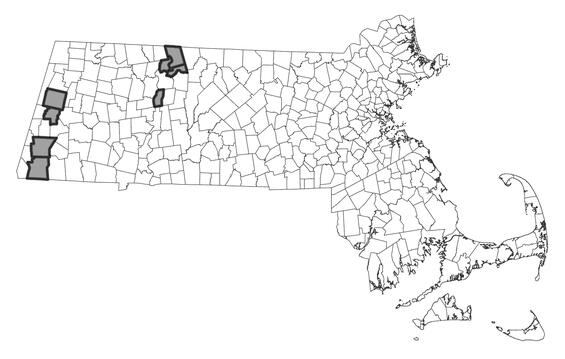- Scientific name: Sagittaria cuneata E.Sheld
- Species of Greatest Conservation Need (MA State Wildlife Action Plan)
- Threatened (MA Endangered Species Act)
Description
Wapato (Sagittaria cuneata) is an aquatic herbaceous perennial plant of the water plantain family (Alismataceae) that occupies circumneutral to slightly basic, primarily open-water habitats. This species is highly variable depending on its growth conditions. Plants may be emergent and emersed, floating, or entirely submerged. The leaves of wapato are generally sagittate (arrow-head shaped), though they exhibit a range of morphology, which varies with water levels. The inflorescence is a long-stalked raceme bearing whorls of white flowers. The fruits are flattened achenes (dry, indehiscent, one-seeded fruits) borne in dense spheres. The most distinguishing trait of this species is the tiny erect beak on the achene. This feature, in combination with the phenotypic plasticity in leaf morphology, clinches wapato’s identification.
Wapato produces basal rosettes of leaves with expanded blades from stoloniferous corms (short, solid, vertical stems), often with tubers. On average, plants grow to about 0.5 m (~1.5 ft) but can reach over 1 m (3.6 ft). Generally, the genus Sagittaria is characterized by basal rosettes of long-petioled sagittate or unlobed leaves. Wapato however, displays three different leaf morphologies tied to the prevailing hydrologic regime. Leaf blades of emersed plants are linear to sagittate with a central lobe that is broad-lanceolate to triangular-ovate, atop recurved petioles. Floating plants in moderate to deep water have heart-shaped or sagittate leaf blades with long triangular petioles. Entirely submerged plants in deep water have long narrow, ribbon-like bladeless phyllodia (expanded leaf-like petioles). Superficially, the flowering raceme looks like other species in the genus, with 2 to 10 whorls of pedicels bearing three-lobed white flowers. Close examination reveals differences such as smaller petals (7–10 mm [0.28-0.4 in] long), and inflorescence bracts (7-40 mm [0.28-1.6 in]) that are thin, dry, and membranous with margins fused at least one-quarter of their total length. The small achenes (1.8-2.6 mm [0.07-0.1 in]) usually have one or no facial wing and erect minuscule beaks (0.1-0.5 mm [<0.02 in]). Wapato flowers in midsummer and fruits midsummer into early autumn.
Common arrowhead (Sagittaria latifolia) is a very similar species. In reproductive condition, common arrowhead can be differentiated from wapato by its larger petals (10-20 mm [0.4-0.79 in]), the larger achenes (2.5-4 mm [0.1-0.16 in]), and generally smaller, boat-shaped bracts (3-8 mm [0.12-0.31 in]). In addition, the beak on the achene of common arrowhead is longer (0.6-1.8 mm [0.02-0.07 in]) than that of wapato, and has beaks that are horizontally spreading (not erect). Common arrowhead differs from wapato in leaf characters as well. When emersed, its leaves have ascending (not recurved) petioles, giving plants an erect appearance; the central lobes of the blades are linear to broad-ovate; and plants do not produce floating leaves with expanded blades.
Life cycle and behavior
This is a perennial species.

Population status
Wapato is listed under the Massachusetts Endangered Species Act (MESA) as Threatened. All listed species under MESA are protected from killing, collecting, possessing, or sale and from activities that would destroy habitat and thus directly or indirectly cause mortality or disrupt critical behaviors. There are 11 populations that have been verified since 1999 in Berkshire and Franklin Counties.
Distribution and abundance
Wapato is known across Canada, from most New England States south to New Jersey, throughout the Midwest, Southwest, Rocky Mountain region, Pacific West, and Alaska. It is notably absent from the southeastern United States. In New England, it is critically imperiled in Connecticut and New Hampshire, imperiled in Massachusetts, vulnerable in Vermont, not assessed in Maine, and not known to occur in Rhode Island.

Habitat
In Massachusetts, wapato is found primarily in riverine floodplain habitats in alkaline backwaters, oxbow ponds, and small shallow depressions with muddy substrate. A few occurrences have been found on pond shores. Wapato particularly favors stagnant or very slow-moving water. Associated species include canopy species such as silver maple (Acer saccharinum), and a sparse shrub layer with a species such as buttonbush (Cephalanthus occidentalis). Frequently co-occurring herbaceous plants are common arrowhead (Sagittaria latifolia), false water-pepper (Persicaria hydropiperoides), water-plantains (Alisma spp.), bur-reeds (Sparganium spp.), and submerged and floating species such as coontail (Ceratophyllum demersum) and pondweeds (Potamogeton spp.).
Healthy habitats are vital for supporting native wildlife and plants. Explore habitats and learn about conservation and restoration in Massachusetts.
Threats
This species is truly aquatic; thus, changes to the hydrologic conditions due to local land use could threaten the viability of a wapato population.
Conservation
The exact management needs of wapato are not known. As with all species, however, maintaining habitat quality is essential. Water quality and quantity should be preserved; water quality degradation due to inputs of sediments, toxins, and nutrients from fertilizers or animal waste could change the water and soil chemistry, and favor establishment of exotic or aggressive generalist species. Wapato’s habitat should be monitored for exotic invasive species. Invasive plants can out-compete native plants for nutrients and light, excluding them over time. Exotic species of concern in the floodplain plant communities of wapato include moneywort (Lysimachia nummularia), purple loosestrife (Lythrum salicaria), yellow iris (Iris pseudacorus), Eurasian water-milfoil (Myriophyllum spicatum), and reed canary grass (Phalaris arundinacea). If exotic plants are invading wapato’s habitat, a plan for control should be constructed. All active management within the habitat of a rare plant population (including invasive species removal) is subject to review under the Massachusetts Endangered Species Act and should be planned in close consultation with MassWildlife’s Natural Heritage & Endangered Species Program.
Contact
| Date published: | May 8, 2025 |
|---|